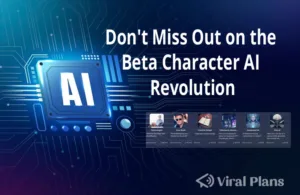
In today’s digital age, the field of artificial intelligence is continually evolving. Among the many exciting advancements, Beta Character AI stands out as a fascinating and innovative concept. This comprehensive guide will take you on a journey to explore the world of Beta Character AI from its origins to its potential applications. We’ll delve into the technology, discover its real-world use cases, and understand why it’s gaining such prominence in various industries.
What Is Beta Character AI?
To kickstart our exploration, let’s begin with the basics. Beta Character AI, often referred to simply as Beta AI, is a sophisticated branch of artificial intelligence. It’s designed to create and manipulate virtual characters, enhancing the realism and interactivity of video games, simulations, and other virtual environments. By doing so, it elevates the overall user experience to new heights.
Beta AI is a hot topic not only among developers and AI enthusiasts but also among the gaming community. Its primary purpose is to simulate human-like behavior in virtual characters, making them more responsive and lifelike. This innovation opens the door to an array of exciting possibilities.
The Origins of Beta Character AI
Understanding the origins of Beta AI helps shed light on how it has evolved and grown. The roots of this technology trace back to the early days of video games, where developers sought ways to make characters more engaging and dynamic.
In the past, AI-driven characters were limited by predefined scripts and behaviors, making interactions with them feel repetitive and, at times, frustrating. The birth of Beta AI aimed to change this by introducing learning algorithms that allowed characters to adapt and respond to player actions, creating a more immersive experience.
Exploring Beta AI in Detail
Now that we have a foundational understanding of Beta Character AI let’s delve deeper into its key components and how it functions:
Learning Algorithms: At the core of Beta AI are advanced learning algorithms. These algorithms enable virtual characters to learn from their interactions and adapt their behavior accordingly. This means that characters in video games and simulations become more responsive and capable of handling complex scenarios.
Behavior Modeling: Beta AI excels at modeling human-like behavior. Through intricate programming, it can simulate emotions, decision-making processes, and even the nuances of social interactions. This is a pivotal feature, as it allows for more engaging and realistic virtual worlds.
Scalability: One of the strengths of Beta AI is its scalability. Developers can implement this technology in a wide range of projects, from indie games to massive online multiplayer simulations. This flexibility has contributed to its widespread adoption.
Real-World Applications of Beta Character AI
The beauty of Beta Character AI lies in its versatility.
Gaming: The gaming industry is at the forefront of Beta AI adoption. Gamers can now engage with more intelligent and responsive non-player characters (NPCs), creating richer and more challenging gaming experiences. BLAST FURNACE MINECRAFT GAME
Education: In the educational sphere, Beta AI can play a significant role in creating immersive simulations for training and learning. Students can practice real-world scenarios in a safe and controlled virtual environment.
Healthcare: The healthcare sector is exploring the use of Beta AI for medical training simulations. This technology offers a risk-free platform for medical students to hone their skills before working with real patients.
Entertainment: Beyond gaming, Beta AI enhances the entertainment industry. Virtual characters in movies, TV shows, and amusement park attractions can now provide more interactive and engaging experiences for audiences.
The Future of Beta Character AI
The evolution of Beta Character AI shows no signs of slowing down. As technology advances, we can expect even more exciting developments in this field. Developers are continually refining and expanding the capabilities of Beta AI, making it a crucial component of the AI landscape.
In the coming years, we can anticipate:
Enhanced Realism: Virtual characters will become indistinguishable from real humans, offering more immersive experiences in various applications.
Broader Adoption: As the technology becomes more accessible, it will find its way into a broader range of industries and applications.
Ethical Considerations: The use of Beta AI will raise ethical questions about the boundaries of AI in gaming, entertainment, and other areas. Striking a balance between realism and responsibility will be an ongoing challenge.
Conclusion
In summary, Beta Character AI represents a remarkable leap forward in the field of artificial intelligence. With its ability to create lifelike and responsive virtual characters, this technology is revolutionizing gaming, education, healthcare, and entertainment. Its applications are vast and continue to grow, promising a future filled with more immersive and engaging experiences.
As technology continues to evolve, Beta AI will undoubtedly be at the forefront of innovation. It’s an exciting journey, and we can’t wait to see how this technology will shape our digital world in the years to come. So, keep an eye on Beta Character AI, for the future is promising, engaging, and profoundly realistic.